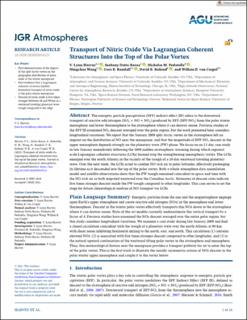| dc.contributor.author | Harvey, Lynn V. | |
| dc.contributor.author | Datta-Barua, Seebany | |
| dc.contributor.author | Pedatella, Nicholas M. | |
| dc.contributor.author | Wang, Ningchao | |
| dc.contributor.author | Randall, Cora E. | |
| dc.contributor.author | Siskind, David E. | |
| dc.contributor.author | van Caspel, Willem Elias | |
| dc.date.accessioned | 2021-06-01T07:40:52Z | |
| dc.date.available | 2021-06-01T07:40:52Z | |
| dc.date.created | 2021-05-31T16:24:24Z | |
| dc.date.issued | 2021 | |
| dc.identifier.citation | Journal of Geophysical Research (JGR): Atmospheres. 2021, 126 (11), . | en_US |
| dc.identifier.issn | 2169-897X | |
| dc.identifier.uri | https://hdl.handle.net/11250/2757141 | |
| dc.description.abstract | The energetic particle precipitation (EPP) indirect effect (IE) refers to the downward transport of reactive odd nitrogen (NOx = NO + NO2) produced by EPP (EPP-NOx) from the polar winter mesosphere and lower thermosphere to the stratosphere where it can destroy ozone. Previous studies of the EPP IE examined NOx descent averaged over the polar region, but the work presented here considers longitudinal variations. We report that the January 2009 split Arctic vortex in the stratosphere left an imprint on the distribution of NO near the mesopause, and that the magnitude of EPP-NOx descent in the upper mesosphere depends strongly on the planetary wave (PW) phase. We focus on an 11-day case study in late January immediately following the 2009 sudden stratospheric warming during which regional-scale Lagrangian coherent structures (LCSs) formed atop the strengthening mesospheric vortex. The LCSs emerged over the north Atlantic in the vicinity of the trough of a 10-day westward traveling planetary wave. Over the next week, the LCSs acted to confine NO-rich air to polar latitudes, effectively prolonging its lifetime as it descended into the top of the polar vortex. Both a whole atmosphere data assimilation model and satellite observations show that the PW trough remained coincident in space and time with the NO-rich air as both migrated westward over the Canadian Arctic. Estimates of descent rates indicate five times stronger descent inside the PW trough compared to other longitudes. This case serves to set the stage for future climatological analysis of NO transport via LCSs. | en_US |
| dc.language.iso | eng | en_US |
| dc.publisher | American Geophysical Union, AGU | en_US |
| dc.rights | Attribution-NonCommercial-NoDerivatives 4.0 Internasjonal | * |
| dc.rights.uri | http://creativecommons.org/licenses/by-nc-nd/4.0/deed.no | * |
| dc.title | Transport of Nitric Oxide Via Lagrangian Coherent Structures Into the Top of the Polar Vortex | en_US |
| dc.type | Peer reviewed | en_US |
| dc.type | Journal article | en_US |
| dc.description.version | publishedVersion | en_US |
| dc.source.volume | 126 | en_US |
| dc.source.journal | Journal of Geophysical Research (JGR): Atmospheres | en_US |
| dc.source.issue | 11 | en_US |
| dc.identifier.doi | https://doi.org/10.1029/2020JD034523 | |
| dc.identifier.cristin | 1912907 | |
| dc.description.localcode | © 2021. The Authors. This is an open access article under the terms of the Creative Commons Attribution-NonCommercial-NoDerivs License, which permits use and distribution in any medium, provided the original work is properly cited, the use is non-commercial and no modifications or adaptations are made. | en_US |
| dc.source.articlenumber | e2020JD034523 | en_US |
| cristin.ispublished | true | |
| cristin.fulltext | original | |
| cristin.qualitycode | 2 | |

